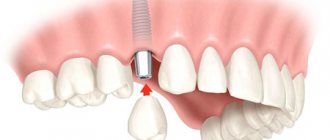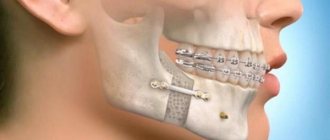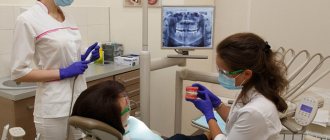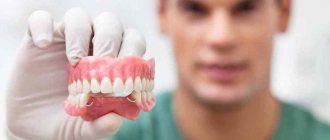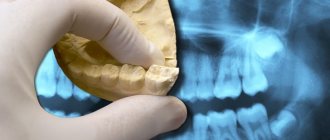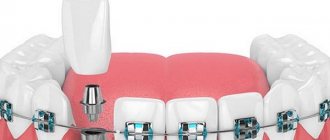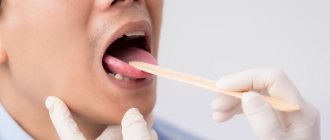An orthodontist is a person who deals with the correction and elimination of anomalies of the dental system. It is to him that people turn to with similar problems: a protruding jaw, a too narrow chin, crooked incisors, etc. Such a specialist takes on congenital, acquired in childhood and hereditary defects. Moreover, he can work with patients of any age.
Some people believe that correcting the abnormal position of teeth can only be done in childhood. This is wrong. In a child, the treatment process is simpler, but a congenital or hereditary problem can develop in adulthood or worsen over time. If this happens, do not hesitate to contact your doctor.
What diseases does an orthodontist treat?
As already mentioned, an orthodontist deals with congenital, hereditary and acquired dental defects in childhood. This doctor does not work with injuries and does not set the jaw. Most often, an orthodontist is consulted with the following problems:
- facial asymmetry;
- improper growth of teeth;
- violation of chewing functions;
- abnormal position of teeth, etc.
After the examination, the doctor assesses the patient’s condition, studies the causes of the disease and selects a treatment method. Let's take a closer look at the classification of diseases that a doctor encounters.
Anomalies of teeth
Dental anomalies are various deviations of individual elements of the dentition. The following types of abnormal dental development are distinguished:
- violation of shape (spike-shaped, Hutchinson, Fournier, Pfluger teeth);
- non-standard size (micro- and macrodentia);
- too few or too many teeth (edentia, hypodontia, hyperdontia);
- problems with tissue structure (hypoplasia, hyperplasia);
- incorrect timing of appearance (premature or late);
- incorrect position of an individual tooth in the dentition (oral, vestibular, distal, mesial, infraposition, supraposition, rotation around the longitudinal axis, transposition);
- discoloration.
The picture below shows the most common anomalies of individual teeth.
The most common dental abnormalities
Anomalies of the dentition
The dentition can also have anomalies, which sometimes greatly disturb the patient and cause problems with nutrition and speech. The following are the problems faced by orthodontists:
- violation of the row shape;
- incorrect size towards narrowing/widening or lengthening/shortening;
- violation of the sequence of teeth;
- violation of the symmetry of the position of the teeth;
- violation of contacts between teeth (twisted or sparse position).
Malocclusions
Malocclusion is the most common problem that everyone hears. Sometimes patients even get the impression that orthodontics in dentistry deals exclusively with installing braces. Of course, this is not true, but bite correction is one of the most common problems, especially in childhood.
There are five types of malocclusion:
- distal, when the upper jaw is overdeveloped and protrudes forward, significantly affecting facial features;
- mesial, in which the lower jaw is already too developed;
- cross. Its owners have free space between their teeth, and they themselves are arranged “like scissors”;
- deep, in which the lower teeth are practically hidden under the upper ones;
- open, when there is no constant contact between the lower and upper teeth, it appears only in the area of the molars.
An incorrect bite, even if it is not very pronounced, is no less dangerous a problem than a tooth out of alignment or a violation of symmetry.
Malocclusion: main types
You will find detailed information on this topic in the article: All about the bite: what it is like, why it is important to monitor it and how to treat improperly grown teeth
Jaw anomalies
The jaws may also not be positioned quite correctly, is immediately visible to the orthodontist Examples of the most common pathologies:
- altered size (macrognathia or micrognathia), when one of the jaws has reached a much larger size in development than the other. It may be different: the jaws often remain small. The problem may be with only the upper or lower jaw or both;
- incorrect location relative to the base of the skull. There are asymmetric placement, prognathia (strong protrusion forward), retrognathia (movement of the jaw backward);
- abnormal relationship of the dental arches (distal or mesial occlusion, excessive overlap, non-standard occlusions.
The types of disorders of the dental system largely overlap, because, for example, it is impossible to consider the position of the teeth without taking into account the entire dentition. Therefore, if you understand who an orthodontist is in dentistry , then we can say that he is, first of all, a practitioner. He takes into account the characteristics of a particular patient and draws up a completely individual treatment plan.
Who is an orthopedic dentist?
An orthopedic dentist is a specialist who installs implants and dentures. Prosthetics are used when it is necessary to restore the crown of a tooth . If the root is destroyed, then it becomes necessary to install an implant.
The appropriateness of a particular type of treatment (installation of a prosthesis or implant) is determined by an orthopedic surgeon after consultation with the patient and conducting the necessary research.
Patients of different genders and ages turn to an orthopedic dentist. Some people want to correct the shape of their teeth or color; others want to install implants instead of an extracted tooth.
Those who want to replace existing prostheses with new ones made of a different material also visit the doctor.
Basic methods of orthodontic treatment
Without knowing what exactly the patient came with, it is impossible to say what the orthodontist will do , because the methods of influence primarily depend on the problem and defects in the dentition. Sometimes you can get by with minimal interventions, in other cases you need to involve a dental surgeon.
The most popular methods of dental orthodontism are myotherapy or myogymnastics, hardware treatment and surgical intervention. It is rare that these methods are used in their “pure” form; usually the doctor combines them, forming the course of treatment necessary for a particular patient.
Myotherapy
Myotherapy is one of the ways to strengthen the muscles of the maxillofacial area, thanks to which the formation of anomalies in childhood can be avoided. Based on theoretical calculations about orthodontic treatment, we can conclude that this is the safest and least effective method. Therefore, myogymnastics is almost never prescribed separately.
During classes, the child needs to perform two types of exercises:
- dynamic, when the muscles of the face and jaw sometimes tense and then relax;
- static, forcing the organs to be in tension all the time.
Considering that the exercises must be systematic, classes require adult supervision. Also, it is the parent or teacher who checks that the tasks are completed correctly, because the child may forget or not understand the doctor. The specialist selects tasks, then teaches the adult the exercises, then the adult checks the child.
Myogymnastics class in a children's group: warm-up
Hardware method
The frequency of use of the method clearly shows: an orthodontist is a doctor who treats with fixed and removable hardware systems. The most famous of them are braces, mouth guards and trainers, and plates. When installed, they act on individual teeth, causing them to slowly but surely move in the desired direction. As a result, all elements of the oral cavity occupy their intended position.
Treatment with devices has certain limitations. So, corrections are possible if:
- sufficient force is applied to the tooth, i.e. the equipment is assembled correctly and installed correctly;
- the device has a reliable support and is well fixed;
- there is a place in the dentition into which a stray element can fit;
- there are no obstacles in the path of the tooth being moved.
If these rules are not followed, the dental orthodontist corrects this , and then installs braces, plates or other devices. Sometimes it takes a lot of time to prepare, because it is necessary to remove excess teeth and wait for the restoration of the oral cavity.
Surgical method
If the diagnosis shows that the deformation of the development of the dental arches, jaws or malocclusion is too pronounced, it is necessary to resort to surgical methods. The most popular types of surgical intervention:
- exposure of the crown of an impacted tooth (i.e., removal of the upper gum tissue above a tooth that has not erupted correctly);
- rotation of the tooth around its axis, as a result of which the element falls into place in the dentition correctly;
- removal of individual teeth of irregular shape, extra teeth, as well as those that cannot be “fitted” into the jaw for some reason, etc.
In some situations, surgical intervention falls under the purview of what an orthodontist does . If the specialist cannot correct the situation on his own, he gives the person a referral to a dental surgeon.
What does orthopedics do?
According to the definition, orthopedic dentistry deals with the identification and treatment of violations of the integrity and functions of the dental system. This is possible through the installation of removable or fixed prostheses and corrective devices. At the dawn of orthopedic dentistry, this range of services meant only prosthetics. Today, this includes the prevention of the development of jaw deformities.
Types of dental prosthetics include:
- Implant prosthetics is a universal method that is used for complete or partial tooth loss. With the help of a prosthesis, chewing function is restored. Such designs do not imply restrictions in operation.
- Inlays are special fillings that are made in advance in the laboratory. Installed using a fixing compound. Durable, do not shrink.
- Veneers are ceramic shells that are placed on the front side of teeth. Serve to eliminate external defects (irregular shape, chips, pathological abrasion of enamel). Made individually, they improve the appearance of your smile.
- Crowns are special attachments, or “caps,” that are used when a tooth is completely or partially deformed (when installing a filling is not advisable). They are made of metal-ceramics, composite materials, plastic, and metal.
- Bridges - used to replace a lost tooth or group of teeth.
They are installed using a support (at least two), which are whole healthy teeth. They are made from the same materials as crowns.
- Removable dentures - these include clasp and plate dentures. Used in cases of severe damage to the dentition.
When to contact an orthodontist
A child should learn who an orthodontist is before the age of 7. At this age, the permanent bite of the anterior incisors is still forming, so it is possible to stop some problems relatively painlessly. Most leaflets for parents contain the following recommendations for visiting a doctor:
- The child is one year old and parents have questions. What does an orthodontist do when the baby has no teeth yet? He examines whether the lips and those teeth that have already erupted are closing correctly;
- child is 3 years old. A visit is advisable, because at a young age, the prerequisites for incorrect development of teeth and jaws can be identified. Therefore, during such an appointment, the orthodontist always asks the parents whether the baby has bad habits, for example, sucking a pacifier, finger, tongue;
- the child has difficulty swallowing, chewing, and speech is not formed;
- you see that the child has changes in the position of the teeth or their closure.
Knowing what an orthodontist does , you can visit a specialist in advance to prevent problems in the development of the dentition and avoid their deterioration.
What are the tasks of a doctor?
When visiting an orthopedic dentist, the oral cavity is examined. The specialist’s task is to assess the condition:
- teeth;
- gums;
- mucous membrane;
- masticatory muscles;
- temporomandibular composition.
To obtain a complete picture of the condition of the oral cavity, an x-ray is prescribed. The doctor can take an impression of the patient's jaw if necessary .
As a result of examination and research, the orthopedic dentist makes a diagnosis and prescribes treatment. Depending on the degree of tooth decay, prosthetics or restoration are offered.
The task of the orthopedic dentist is to restore the functions of the tooth as much as possible.
The following technologies are used for this:
- veneers - installed if it is necessary to eliminate cosmetic defects of the front teeth (chips, unevenness, color);
- crowns - installed on pulpless teeth;
- inlays are artificial fillings made of ceramics.
If the tooth root is destroyed, the orthopedic dentist will suggest installing an implant.
Diagnostics
On average, a diagnosis by an orthodontist takes 30 to 40 minutes, but can take several days. It all depends on the patient’s desire to take certain photographs. Standard procedures included in the diagnostic list:
- visual inspection;
- a panoramic photograph that allows you to see the full view of the jaws, including the roots of the teeth, wisdom teeth, and tooth buds;
- teleroentgenogram (TRG). It allows you to determine the cause of the anomaly, see the relationship of the jaws, and draw a conclusion about what treatment methods will be required;
- 3D scanning or taking impressions of the jaws, with the help of which the exact dimensions of the jaw are determined;
- photographing. It allows you to assess changes in the patient’s appearance and the dynamics of treatment;
- 3D analysis or computed tomography (CT). Required if the doctor suspects a non-standard tooth tilt or other complex problems;
- video recording that allows you to record functional disorders in movement.
What is the name of the doctor who makes prostheses, and who can install them?
An orthopedic dentist performs dental prosthetics, including installing crowns. However, other specialists also work with the patient before installing the prosthesis.
- The dentist-therapist carries out treatment of the tooth, mucous membranes and gums, sanitation of the oral cavity, removal of stones and plaque.
- A dental surgeon removes a root that cannot be treated. At this stage, the surgeon implants an implant into the patient’s jaw on which the prosthesis will be installed.
- Then the dental technician gets involved in the work . Based on a cast of the patient’s jaw and other information, a prosthesis is made in a dental laboratory, which is then installed by an orthopedic dentist.
An orthopedic dentist often works in conjunction with an orthodontist to correct dentition.
Stages of consultation and treatment
You need to understand that orthodontic treatment is a long-term process that requires several appointments, or even years of treatment. One visit won't solve anything. The doctor acts as follows:
- First comes the diagnosis, which usually includes not only a visual examination, but also a variety of research methods, for example, orthopantomogram, x-ray, teleradiography. All directions are issued at the first visit.
- Afterwards, the doctor chooses a treatment and prepares the patient for it. The specialist does a lot of work without the client’s participation, for example, everything that an orthodontist does when preparing braces, crowns, etc. The doctor works using photographs, impressions and other tools, analyzing the data obtained during diagnosis.
- The third stage is the installation of hardware in the patient’s oral cavity. This usually doesn't take much time.
- Next comes monitoring how the treatment progresses. If problems are observed, the specialist will correct them in a timely manner.
- The last stage is the removal of devices to correct the dentition.
It is noteworthy that if parents know who an orthodontist is through personal experience, then the child will also most likely get to know this specialist. Many problems, unfortunately, are hereditary.
Indications and contraindications
Implantation cannot be performed at the first visit, only at the request of the patient. In order to install implants, the dentist must confirm the indications for surgery.
Indications include pathologies of the dentition or jaw bones:
- missing one tooth;
- absence of 2 or more dental organs, with adjacent location;
- absence of the last teeth without the possibility of restoration by other methods;
- complete edentia (congenital pathology characterized by the absence of teeth);
- the presence of reasons preventing the wearing of a removable denture (for example, a gag reflex);
- pain caused by functional occlusion;
- absence of alveolar processes in the upper jaw with concomitant complete absence of teeth;
- anatomical defects that arise as a result of diseases, mechanical effects, as well as as a result of disturbances during intrauterine development or genetic predisposition.
In implantology, each case is necessarily considered taking into account the individual characteristics of the dental composition and jaw structure of each patient. An implant can be placed only after diagnosis. A qualified specialist will not carry out the procedure without a preliminary examination.
Contraindications
Diagnostics are necessary not only to confirm the indications, but also to determine the possible presence of contraindications to implantation.
Absolute contraindications for which implants should not be installed include diseases and pathological conditions:
- severe diseases of the cardiovascular system;
- malignant oncological diseases;
- diseases of the nervous system;
- blood pathologies (especially poor clotting);
- severe connective tissue diseases;
- open tuberculosis;
- liver/renal failure during exacerbation;
- increased tone of the masticatory muscles in combination with bruxism;
- diabetes mellitus;
- immunodeficiency diseases;
- allergic reaction to painkillers;
- addiction to drugs or alcohol.
Implantation is not carried out for women carrying a child, as well as for children under 18 years of age. Fixed dentures are not installed until the age of 22. This is due to the fact that until the age of 22, a person’s jaw continues to grow and form. Between the ages of 22 and 25, surgery is performed only for serious indications.
Conclusions. Expert advice
After reading the material, you understand who an orthodontist-dentist is and why you need to visit him regularly. If we summarize what has been said, we can draw the following conclusions:
- the sooner you see a doctor with a problem, the better;
- It is not necessary to prepare for the visit, but if you tell your child in advance about which specialist you are going to, this will simplify the visit to the orthodontist and make it easier for the child;
- Treatment almost always takes a lot of time, but it gives results.
How is the installation carried out?
A dental crown serves to restore a badly damaged tooth, its functions and aesthetic appearance.
What is this product?
The product is a fixed prosthesis in the form of a single element that is attached to a tooth or implant. The prosthesis replaces the coronal (visible) part.
Installation of a “cap” is required if the visible part of the tooth is destroyed by more than 70%. Fillings or microprostheses (inlays) do not provide optimal redistribution of the chewing load and quickly become unusable. The choice between a filling, an inlay and a crown is made by an orthopedic dentist according to the indications:
- caries damage to more than 50% of tooth tissues;
- aesthetic defects (large chips, discoloration);
- pathological abrasion of enamel;
- fracture of the coronal part.
Kinds
The classification of crown prostheses is carried out according to the material from which they are made. The material affects strength, durability and final cost. They are:
- Metal - made of titanium alloys, stainless or cobalt chrome steel. There are also crowns made of gold and platinum. Such implants provide complete restoration of the chewing function of the tooth, but have an unaesthetic appearance. One of the most affordable (except for gold and platinum).
- Metal-ceramic ones are durable and have a natural appearance. The internal part of the structure is made of metal, the external part is ceramic.
- Ceramic - Excellent for prosthetics of front teeth. They have a natural appearance.
Ceramics is the most biocompatible material. The strength of the material may not be sufficient for prosthetics of chewing teeth. One of the most expensive types of crowns.
- Metal-plastic - have a short service life (1-3 years), are used as a temporary measure. Used when installing on an implant or ground tooth. Advantages - affordable price.
- Plastic - used for temporary prosthetics. Quickly produced. Affordable price.
- Zirconium - hypoallergenic, durable. They have high aesthetic properties. They are not inferior in strength to metal structures. Expensive.
Video about types of crowns and installation methods:
Installation
- Before installing a prosthesis, the patient undergoes a consultation with an orthopedic dentist, where the doctor collects an anamnesis, performs a visual examination of the oral cavity and assesses the condition of the teeth and gums. The dentist offers an individual treatment plan, suggests materials for making the crown and calculates the approximate cost of the procedure.
- The patient must undergo an x-ray examination. The image allows you to assess the possibility of restoring a tooth with a prosthesis.
- Next, the patient visits a dentist to treat caries and remove tartar. In most cases, treatment is accompanied by removal of the pulp. An exception is possible when replacing lateral teeth with prosthetics.
- The next stage is turning, or preparing the tooth. As a result of the manipulation, a layer of dentite equal to the thickness of the future crown is removed.
- In order for the tooth crown to be installed correctly, an impression must be made.
Based on the impression, a prosthesis is made in a dental laboratory. In the meantime, the patient will receive a temporary structure if necessary. As a rule, this is done for teeth in the frontal zone so that a person does not have an unsightly ground tooth until a permanent crown is installed.
- The finished product is first tried on and then installed in the patient’s oral cavity. The crown is attached with special cement.
Even metal and ceramic crowns have a limited lifespan . The prosthesis is installed for 5-10 years, after which it must be replaced. Otherwise, you may end up with the crown simply flying off or breaking, and the patient swallowing it.
The material of the product is not toxic to the body, but the sharp edges of the product can damage the walls of the digestive organs. If a large fragment or the entire crown gets into the esophagus, you need to contact an emergency room or a gastroenterologist.
It is impossible to say which prosthesis is definitely better. Each case is individual. The most important thing is to take a responsible approach to choosing a clinic and a specialist , follow the doctor’s recommendations for caring for the product and change the prosthesis on time.
Indications for installation of dental crowns
Dental crowns are installed for the following diseases and conditions:
- injuries and pathological processes of hard dental tissues, accompanied by the destruction of crowns by more than half and the impossibility of restoration with fillings - deep caries, increased abrasion, fractures and dislocations, wedge-shaped defects;
- congenital and acquired defects in the shape, height and position of teeth; congenital underdevelopment of crowns (hypoplasia);
- changes in tooth color - fluorosis, darkening after treatment;
- for support with partially removable and fixed dentures;
- as part of another orthopedic design, for example, splinting loose teeth due to periodontal diseases (periodontitis or periodontal disease).
Who does prosthetics and dental implants?
If you are interested in which doctor places dental crowns, then know that this is done by an orthopedist - a doctor of narrow specialization who can combine his function with another dental specialty. Often, a prosthetist combines practice with surgical activities, since the installation of many prostheses requires surgical intervention.
The services of an orthopedic surgeon are in demand to implant an artificial root into the bone, install an abutment and fix a crown on it. Implantation is a serious intervention that requires a comprehensive diagnosis of the mouth. Based on the results, the specialist develops a prosthetic plan and makes impressions for the crown.
How to place crowns on front teeth
After diagnosis, determination of the treatment plan and selection of the type of future crowns, the process consists of 3 stages:
- the root canals are filled, a pin or stump is installed on the front tooth;
- the tooth is ground with a diamond bur to remove hard tissue; An impression is taken and a prosthesis is made;
- the crown is fixed.
Patients who are most concerned about the question of whether it hurts to put a crown on a tooth have nothing to worry about. The entire procedure is performed under local anesthesia.
If the crowns are placed correctly, a person will not experience discomfort or feel a foreign body in the mouth. If the patient cannot get used to the crowns, then the prosthetics were performed incorrectly.
The iOrtho clinic network provides high-quality services for correcting malocclusion with Invisalign aligners, sign up for a consultation now!
